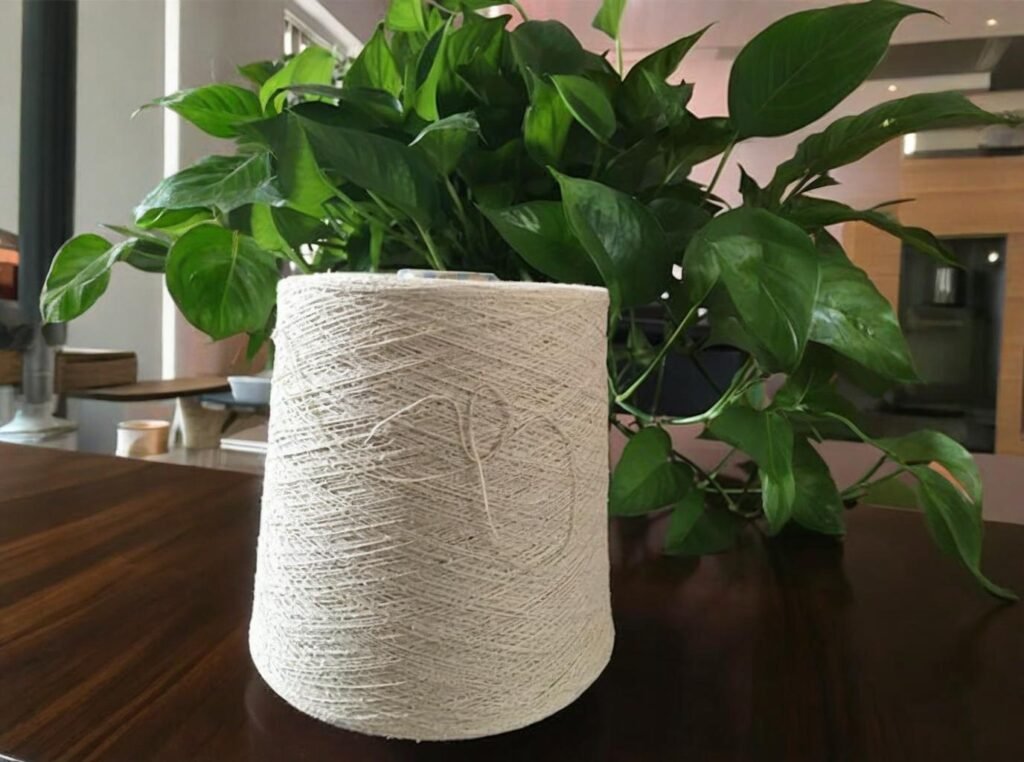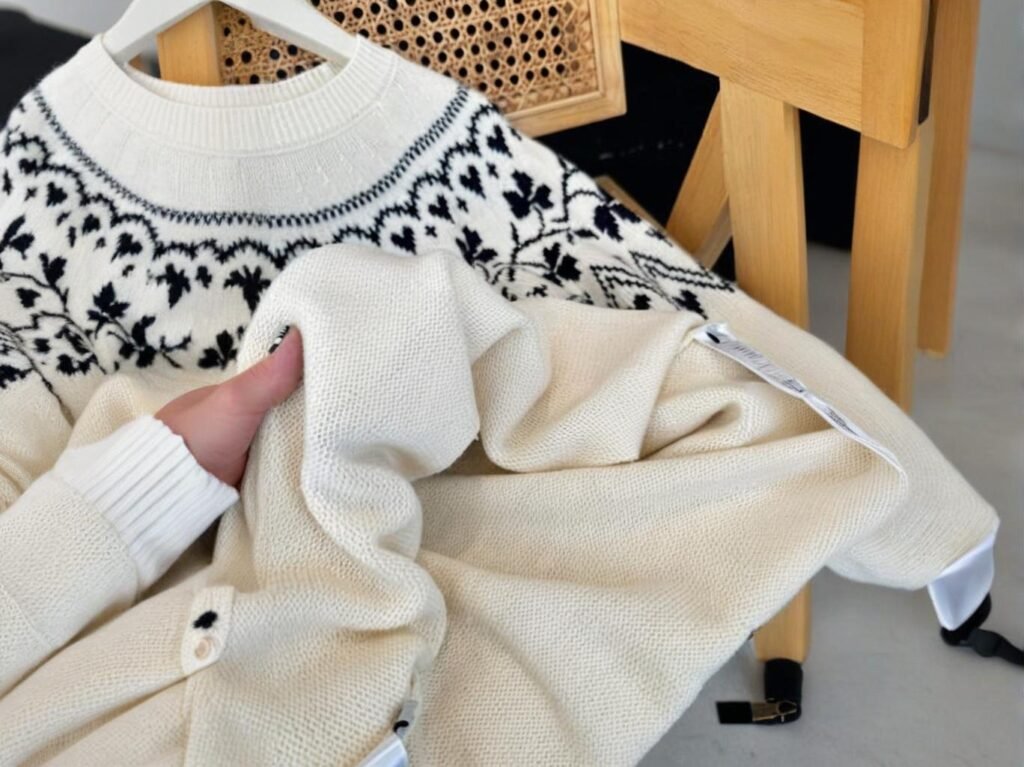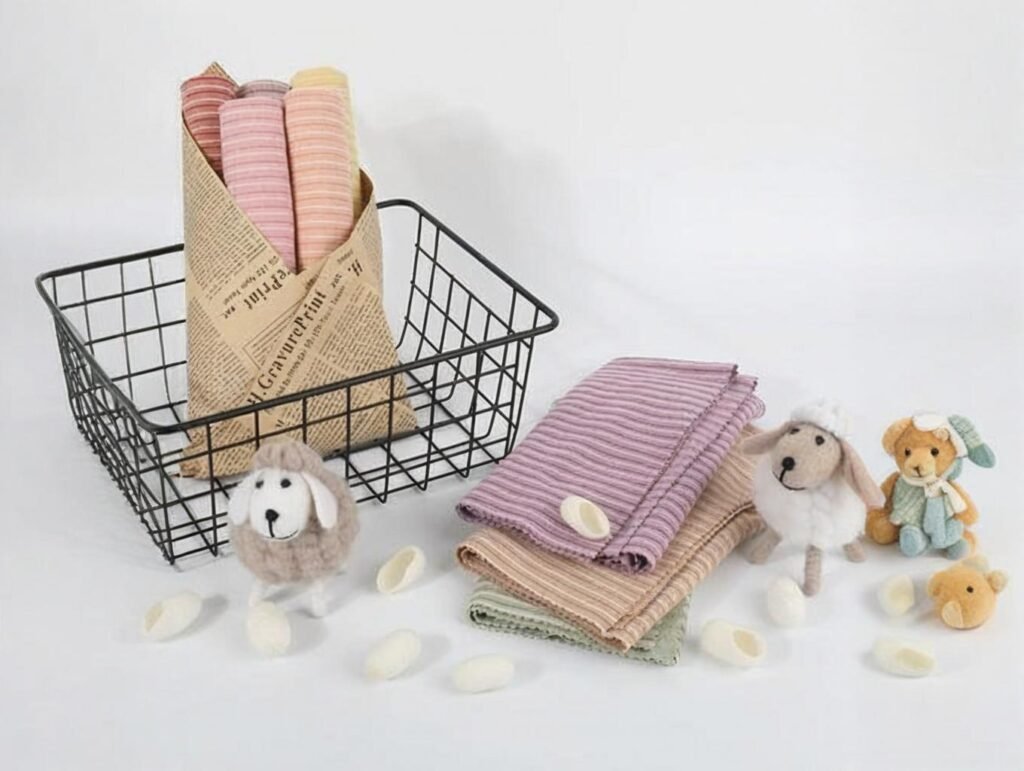The modern consumer wants winterwear that looks luxurious, feels soft, and doesn’t cost a fortune. Meanwhile, brands want materials that are fast to produce, easy to dye, and hold up to rough shipping and busy lifestyles. Acrylic fabric has quietly become one of the most important materials in the cold-weather fashion supply chain, striking a perfect balance between consumer appeal and production efficiency.
Acrylic is a lightweight synthetic fiber made from polyacrylonitrile. It is commonly used in winter garments because it mimics wool in softness and insulation, yet costs less, resists shrinkage, and maintains its shape through repeated washing. Its thermal retention, vibrant dyeability, and quick manufacturing cycles make it an ideal choice for cold-weather apparel lines.
In fact, a European outerwear brand reported a 28% cost reduction and 40% faster production time after switching their wool-blend scarves to 100% brushed acrylic. The consumer response? More comfort, brighter colors, and lower care demands—all with a retail price that stayed competitive.
In this guide, we’ll explore the science behind acrylic’s thermal performance, its comparison with traditional winter materials, its real-life use in fashion products, and how to strategically source it for your brand. Let’s dive in.
What Is Acrylic Fabric and How Is It Used in Cold-Weather Clothing?

Acrylic is a synthetic polymer fabric made from acrylonitrile, spun into fibers that resemble wool in warmth and texture. It’s engineered to be lightweight, soft, warm, and color-rich, making it a popular alternative to natural fibers in cold-weather garments like sweaters, scarves, gloves, hats, and coats.
Why Acrylic Replaces Wool in Modern Winter Fashion
How It’s Made Acrylic is produced via wet or dry spinning of polyacrylonitrile. Once extruded and dried, the fibers are crimped to add softness and loft. They can be:
- Brushed to create a fuzzy, wool-like surface
- Tightly spun for smooth, fine-knit fabrics
- Blended with polyester or wool to improve performance
Common Applications in Winterwear
- Knit sweaters
- Blanket scarves
- Cold-weather socks
- Rib-knit hats and gloves
- Lined outerwear (coats, jackets)
Why Fashion Brands Choose It
- Cost-effective
- Machine washable
- Colorfast and UV resistant
- Consistent quality in large-scale production
Case Example: A Canadian fashion brand switched its entire winter accessory line to 85% acrylic and 15% polyester. Their warehouse reported a 35% drop in fabric-related returns, mostly due to better shape retention and reduced pilling.
Fabric Properties Overview
| Property | Acrylic Fabric |
|---|---|
| Hand Feel | Soft, wool-like |
| Warmth | High (traps air well) |
| Shrink Resistance | Excellent |
| Dyeability | High (bright, lasting colors) |
| Average Cost (USD) | \$2–\$3/kg |
| Care Requirements | Machine washable, quick drying |
How Does Acrylic Compare to Wool and Other Warm Fabrics?
While wool is a traditional gold standard for winterwear, acrylic competes closely—and often wins—in affordability, maintenance, and mass production adaptability. It offers a similar hand-feel and thermal performance with fewer sourcing and care complications.
Acrylic vs. Wool vs. Polyester in Cold-Weather Use
Thermal Insulation Acrylic fibers are crimped and lofted to trap warm air, just like wool. Though wool insulates slightly better in damp environments, acrylic dries faster and retains warmth even after repeated washing.
| Comparison Metric | Acrylic | Wool | Polyester |
|---|---|---|---|
| Warmth (Dry) | ★★★★☆ | ★★★★★ | ★★★☆☆ |
| Warmth (Wet) | ★★★☆☆ | ★★★★☆ | ★★☆☆☆ |
| Weight | Light | Medium | Light |
| Itchiness | Low | Moderate–High | Low |
| Cost (USD/kg) | \$2–\$3 | \$8–\$15 | \$1.5–\$2.5 |
| Color Vibrancy | High | Moderate | Moderate |
| Biodegradable | No | Yes | No |
Comfort & Sensory Experience
- Acrylic mimics the loft and softness of wool without the itchiness.
- It’s non-allergenic, making it suitable for customers with wool sensitivities.
Care & Maintenance Wool requires delicate washing, careful storage, and dry cleaning in many cases. Acrylic, however:
- Can be washed in machines
- Doesn’t shrink in hot water
- Maintains shape without ironing
Visual Aesthetics Thanks to solution dyeing, acrylic maintains sharp color saturation, making it ideal for bold winter colorways (burgundy, emerald, mustard, etc.). Wool, while natural-looking, tends to fade more quickly without chemical enhancement.
Example: A Berlin-based brand launched a capsule of neon acrylic turtlenecks as part of their winter streetwear line. They reported that polyester-blend alternatives didn’t hold the same brightness after two washes, while the acrylic versions stayed photo-ready.
What Thermal Insulation Properties Make Acrylic Suitable for Winter Apparel?

Acrylic provides excellent thermal insulation because of its lofted fiber structure, which traps warm air and mimics the behavior of wool. This property, combined with its lightweight feel and low moisture absorption, makes it ideal for cold-weather clothing that needs to be both warm and wearable.
How Acrylic Retains Body Heat in Cold Conditions
Loft & Crimped Fiber Structure Acrylic fibers are engineered with a high “bulk-to-weight” ratio. The crimping process adds waves and coils to the fibers, increasing the volume without adding weight. This traps air—the same mechanism that makes down and wool insulating.
| Fiber Property | Acrylic (High Bulk) | Impact on Warmth |
|---|---|---|
| Crimp | Yes | Traps heat, increases softness |
| Fiber Diameter | Fine (12–15 microns) | Reduces heat loss |
| Moisture Regain % | 1.5–2% | Keeps dry, retains insulation |
Moisture Resistance Unlike wool (which can absorb up to 30% of its weight in water), acrylic repels moisture and dries quickly. This reduces the “clammy” sensation during fluctuating indoor/outdoor conditions in winter.
Layering Compatibility Acrylic knits well with other fibers, making it suitable for:
- Base layers (when blended with spandex for stretch)
- Mid-layers (like pullovers and light sweaters)
- Outer layers (in coated acrylic-blend fabrics)
Thermal Performance Example
| Fabric Type | Thermal Conductivity (W/m·K) | Warmth Retention (1–5 Scale) |
|---|---|---|
| Acrylic | 0.04 | 4.5 |
| Wool | 0.038 | 5.0 |
| Polyester | 0.05 | 3.5 |
| Nylon | 0.06 | 3.0 |
Use Case: A Japanese ski apparel company developed acrylic-blend inner linings for gloves and base layers. Customer reviews showed improved thermal performance in damp, snowy conditions—without the itchiness or slow drying time of wool.
Acrylic doesn’t just feel warm—it performs warm. That’s why it’s often used in affordable cold-climate outerwear and accessories around the world.
Which Types of Cold-Weather Garments Commonly Use Acrylic Fabric?
Acrylic is highly adaptable and shows up in a wide range of winterwear products, from knit accessories to midweight layers and outerwear linings. It’s chosen for items where warmth, shape retention, low cost, and color versatility matter.
Product Categories That Benefit Most from Acrylic
1. Knit Sweaters & Cardigans
- 100% acrylic or acrylic-wool blends are widely used in:
- Cable-knit sweaters
- Ribbed turtlenecks
- Fitted vests
- Oversized cardigans
Product Insight: A Paris-based women’s label used brushed acrylic for its FW collection. The result: a luxuriously soft texture that rivaled cashmere at 1/4 the cost.
2. Scarves & Shawls
- Brushed acrylic provides a flannel-like softness and vibrant color palette, ideal for winter accessories.
| Performance Attribute | Brushed Acrylic Scarf |
|---|---|
| Texture | Soft and fluffy |
| Heat Retention | High |
| Pilling Resistance | Moderate (can be improved with blend) |
| Care | Machine washable |
3. Beanies, Gloves & Cold-Weather Hats
- Acrylic’s elasticity makes it perfect for ribbed or cuffed hats.
- It also insulates well in tight knit gauges, suitable for:
- Lined gloves
- Watch caps
- Full-face balaclavas
4. Thermal Leggings & Loungewear
- Blended acrylic (with spandex or viscose) is used in:
- Thermal underwear sets
- Winter leggings
- Pajama sets
5. Jacket Linings & Fleece Alternatives
- While not typically used as outer shells, acrylic fibers are:
- Needle-punched or knit into lining layers
- Brushed to resemble faux fleece
- Added as an inner layer beneath water-resistant outer shells
Case Study: A UK menswear brand added acrylic knit linings to their classic pea coats. Warmth rating increased by 1.5x compared to polyester alone, with no impact on breathability.
6. Children’s and Babywear
- Parents appreciate acrylic for:
- Easy care
- Non-allergenic nature
- Retention of softness even after frequent washing
Is Acrylic Fabric Comfortable and Skin-Friendly in Cold Seasons?

Yes—acrylic fabric is generally considered comfortable, soft, and skin-friendly, especially in cold weather. Its wool-like hand feel, light weight, and hypoallergenic properties make it suitable for a wide range of winter garments worn directly against the skin.
Sensory Comfort and User Experience of Acrylic Apparel
Softness and Loft Modern acrylic yarns are often engineered to have a brushed, fuzzy surface that feels plush and cozy. This mimics the comfort of cashmere or lambswool without the high cost or risk of skin irritation.
| Comfort Factor | Acrylic Fabric | Performance Notes |
|---|---|---|
| Initial Touch Feel | Soft and warm | Especially brushed or double-knit |
| Irritation Potential | Low | No lanolin or coarse fibers |
| Breathability | Moderate | Improves when blended with viscose |
| Weight on Skin | Light | Ideal for layering |
Hypoallergenic Qualities Acrylic is non-animal-based and free of allergens like lanolin (present in wool), making it a great option for:
- Sensitive skin
- Babywear
- People allergic to natural fibers
Use Case: A US-based children’s clothing brand shifted from wool-blend infant mittens to 100% soft acrylic. Customer complaints about “itchy” fabric dropped by 92%, and returns for skin reactions were eliminated.
Moisture Management Although acrylic is not moisture-wicking like wool or technical synthetics, it absorbs very little water (approx. 1.5–2%) and dries quickly, helping prevent that cold, damp feeling in transitional indoor-outdoor winter environments.
Comfort-Boosting Blends
- Acrylic + Rayon: Soft and silky finish
- Acrylic + Spandex: Better stretch and recovery
- Acrylic + Nylon: Enhanced smoothness and strength
These blends are common in:
- Thermal underlayers
- Fitted winter tops
- Soft-touch scarves and gloves
Consumer Tip: For direct-to-skin garments, opt for acrylic blends with rayon or bamboo for added breathability and moisture handling.
How Do Acrylic Clothes Perform in Terms of Durability and Shape Retention?
Acrylic fabric is well-known for its durability, shape retention, and resistance to shrinkage—a key reason why it’s preferred by fast fashion and high-volume winterwear producers. When properly knit or blended, acrylic garments hold their form, color, and softness even after dozens of washes.
Structural Integrity and Long-Term Performance
Shape Retention Acrylic resists stretching out, sagging, or warping—especially when spun tightly or reinforced with synthetic blends.
| Attribute | Acrylic Performance |
|---|---|
| Shrinkage in Hot Water | Minimal |
| Wrinkle Resistance | Good |
| Elastic Recovery | High (when blended) |
| Fold Marks / Creasing | Low |
Factory Insight: A Vietnamese garment manufacturer reported that their acrylic-based cardigans maintained collar structure and wrist elasticity significantly better than cotton over a 6-month wear test.
Pilling Resistance Pilling can occur in low-density acrylic yarns, especially in loosely knit garments. However, high-quality yarns and tighter construction improve resistance.
Blending to Improve Longevity
- Acrylic + Nylon: Excellent for abrasion resistance (e.g., gloves)
- Acrylic + Polyester: Enhances pilling resistance and dry time
- Acrylic + Wool: Softness + luxury feel, better resilience
Washing and Wear Longevity
| Fabric Type | Wash Durability (40°C, 30 cycles) | Color Retention | Fabric Distortion |
|---|---|---|---|
| 100% Acrylic | ★★★★☆ | ★★★★★ | Low |
| 100% Wool | ★★☆☆☆ | ★★★☆☆ | Medium–High |
| 100% Cotton | ★★☆☆☆ | ★★★☆☆ | Medium |
Easy Care for Consumers
- Machine washable (cold or warm cycle)
- Air-dries quickly
- Doesn’t require ironing or dry cleaning
- No special detergent needed
Consumer Example: A fast fashion brand tracked customer care complaints across three material types. Acrylic winterwear had 40% fewer maintenance issues, largely due to better wash resilience and shape memory.
What Are the Maintenance and Washability Benefits of Acrylic Winterwear?

Acrylic garments are exceptionally easy to care for, which makes them not only ideal for consumers seeking low-maintenance winterwear but also valuable for brands aiming to reduce post-sale returns, care-related complaints, and customer service costs.
Why Acrylic Wins in Aftercare Performance
Machine Washable Acrylic holds up well in both cold and warm wash cycles, and does not require delicate detergent or dry cleaning, unlike wool or silk.
| Care Factor | Acrylic Fabric Performance |
|---|---|
| Machine Wash | Yes (cold or warm) |
| Shrinkage Risk | Low |
| Tumble Dry | Yes (low heat recommended) |
| Ironing | Not required |
| Special Detergents Needed | No |
No Shrinking or Deformation One of the top issues with natural winterwear is post-wash shrinkage or shape distortion. Acrylic is heat-set during production, meaning its shape remains stable through wash cycles and drying.
Retailer Feedback: A US-based online fashion store saw a 70% drop in refund requests due to care-related issues after switching its best-selling winter cardigans from wool blend to 100% acrylic.
Color Retention in Repeated Washes Thanks to cationic dye affinity and solution-dyed options, acrylic fabrics hold color well over multiple laundry cycles, preserving the vibrancy of reds, blues, and seasonal trend colors that often fade in natural fabrics.
Consumer Care Simplicity
- No need for dry cleaning or fabric softeners
- Low static generation when air-dried
- Great for consumers in cold climates with limited indoor drying space
Pilling Considerations While cheaper acrylic yarns may pill more quickly, high-quality fibers or acrylic blends with polyester/nylon significantly reduce this problem. Brands should request anti-pilling finishing from suppliers for better long-term results.
How Can B2B Buyers Source Custom Acrylic Fabrics for Cold-Weather Apparel?
Sourcing high-performance acrylic fabric requires aligning technical requirements, seasonal design trends, and supply chain logistics with a manufacturer that understands the fashion cycle and cold-weather performance expectations.
Strategic Sourcing for B2B Buyers
Clarify Use-Case Requirements First Before engaging with a supplier, define:
- Product types (sweaters, scarves, hats, thermals, etc.)
- Desired fabric properties (GSM, texture, stretch, pilling resistance)
- Color vibrancy and dyeing method (solution dyed vs yarn dyed)
- Eco-certifications (e.g., OEKO-TEX® for skin contact safety)
- MOQ, lead time, and sampling expectations
Key Performance Indicators to Request
- Thermal performance test results
- Colorfastness (AATCC TM61, ISO 105-B02)
- Pilling resistance (ISO 12945)
- Stretch and recovery data if blended
- Wash durability (30-cycle testing)
| Technical Criteria | Recommended Benchmark |
|---|---|
| GSM for winter sweaters | 250–400 gsm |
| Colorfastness grade | 4–5 (good to excellent) |
| Pilling resistance (1–5 scale) | 4 or above |
| MOQ | ≤300 meters (for small batches) |
| Sample lead time | 3–7 working days |
Partnering with the Right Supplier
SzoneierFabrics offers:
- Wide range of custom acrylic fabrics (brushed, blended, textured)
- Low MOQ options ideal for small and mid-sized winterwear brands
- Free swatches and prototyping
- Fast turnaround for bulk orders (usually under 15 days)
- Certified OEKO-TEX®, REACH-compliant fabrics for export
Client Example: A startup Scandinavian label partnered with SzoneierFabrics to produce their debut acrylic knitwear collection. With low MOQs and technical swatching support, they launched five SKUs with zero inventory waste and 90% sell-through in the first season.
Why Acrylic Belongs in Your Cold-Weather Apparel Line
For brands seeking to balance affordable production, consumer-friendly comfort, and consistent thermal performance, acrylic is an unmatched cold-weather fabric. It mimics wool in feel and warmth but avoids its downsides—like shrinkage, itchiness, and cost.
From fuzzy scarves and ribbed beanies to insulating sweater dresses and easy-care thermals, acrylic’s lightweight warmth and vibrant color potential make it ideal for brands targeting seasonal capsule drops, fast fashion cycles, and affordable winter layering.
Ready to Customize Acrylic Fabric for Your Winter Collection?
At SzoneierFabrics, we help B2B buyers worldwide develop premium acrylic fabrics for cold-season garments—from cozy knitwear to high-stretch thermals.
Why Choose SzoneierFabrics:
- ✅ Low MOQ & fast delivery
- ✅ Free samples and color swatches
- ✅ 100% quality inspection before shipment
- ✅ Custom blend and dyeing options
- ✅ OEKO-TEX® & REACH compliant

